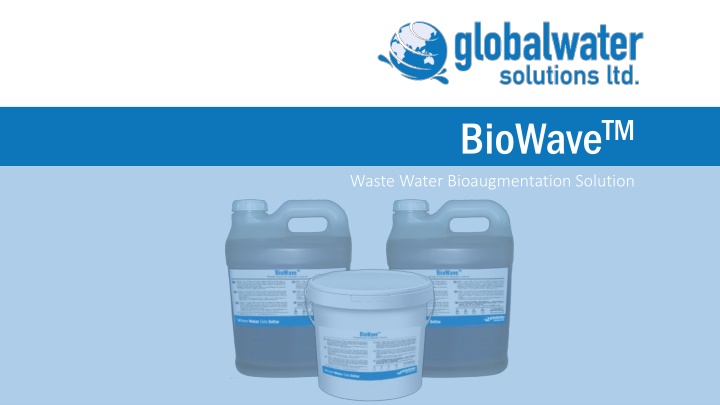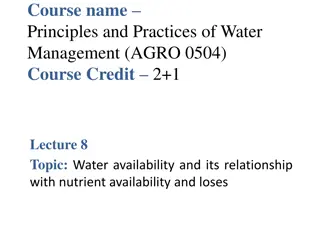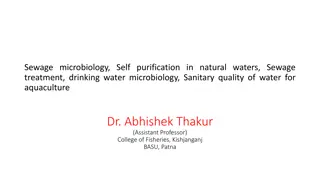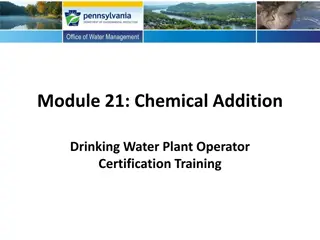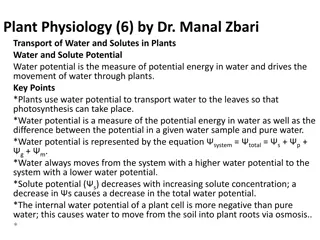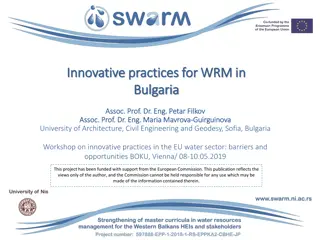Discover BioWaveTM: Innovative Bioaugmentation Solution for Water Treatment
Utilize BioWaveTM, a cutting-edge bioaugmentation solution, to enhance microbial populations in water systems for efficient breakdown and digestion of organic waste. Learn about its application in septic systems, grey water treatment, and ponds/aquaria, and explore the benefits of beneficial microbes and their role in waste water treatment.
Download Presentation

Please find below an Image/Link to download the presentation.
The content on the website is provided AS IS for your information and personal use only. It may not be sold, licensed, or shared on other websites without obtaining consent from the author.If you encounter any issues during the download, it is possible that the publisher has removed the file from their server.
You are allowed to download the files provided on this website for personal or commercial use, subject to the condition that they are used lawfully. All files are the property of their respective owners.
The content on the website is provided AS IS for your information and personal use only. It may not be sold, licensed, or shared on other websites without obtaining consent from the author.
E N D
Presentation Transcript
BioWaveTM Waste Water Bioaugmentation Solution
BioWaveTM What is Bioaugmentation? What is What is Bioaugmentation? Bioaugmentation? Product Overview Product Features Applications Why use BioWaveTM How does BioWaveTM work? How is BioWaveTM applied? Septic Systems Grey Water Ponds / Aquaria Case Studies Bioaugmentation Bioaugmentation is the process where where beneficial microbes are beneficial microbes are added to w added to waste aste w water the the existing microbial existing microbial populations in order to breakdown and digest in order to breakdown and digest organic waste. organic waste. is the process ater to to enhance enhance populations
BioWaveTM What is Bioaugmentation? What is What is Bioaugmentation? Bioaugmentation? Product Overview Product Features Applications Why use BioWaveTM How does BioWaveTM work? How is BioWaveTM applied? Septic Systems Grey Water Ponds / Aquaria Case Studies Microbes Microbes don t have don t have mouths, feed through their cell walls by feed through their cell walls by secreting enzymes into the secreting enzymes into the water. These These secretions secretions are the key to breaking breaking down down and digesting the and digesting the o organic rganic and i and inorganic norganic m matter. mouths, but but water. are the key to atter.
BioWaveTM What products are included in the BioWaveTMSeries? What is Bioaugmentation? Product Overview Product Overview Product Features Applications Why use BioWaveTM How does BioWaveTM work? How is BioWaveTM applied? Septic Systems Grey Water Ponds / Aquaria Case Studies BioWave BioWaveTM TM Beneficial Beneficial microbe microbe liquid solution liquid solution for specialized for specialized wastewater organics degradation, grease control, wastewater organics degradation, grease control, odor reduction, water clarity enhancement, and odor reduction, water clarity enhancement, and biological treatment of ponds and waste water biological treatment of ponds and waste water systems systems
BioWaveTM What products are included in the BioWaveTM Series? What is Bioaugmentation? Product Product Overview Product Features Applications Why use BioWaveTM How does BioWaveTM work? How is BioWaveTM applied? Septic Systems Grey Water Ponds / Aquaria Case Studies BioPellets BioPelletsTM TM Overview Beneficial microbe inoculated Beneficial microbe inoculated pellets designed for enhanced odor pellets designed for enhanced odor and sludge reduction in grey water and sludge reduction in grey water and waste water treatment systems and waste water treatment systems
BioWaveTM What are the main features of BioWaveTM? What is Bioaugmentation? Product Overview Product Features Product Features Applications Why use BioWaveTM How does BioWaveTM work? How is BioWaveTM applied? Septic Systems Grey Water Ponds / Aquaria Case Studies Microbe Strains are Microbe Strains are a all Derived Naturally from ll Derived Naturally from t the Earth he Earth Not Genetically Modified Not Genetically Modified All All- -Star Teams of Star Teams of Carefully S Carefully Selected elected Bacteria, Yeast, and Fungal Strains Bacteria, Yeast, and Fungal Strains Extremely High Concentrations Levels Extremely High Concentrations Levels Able To Perform Both Aerobically and in Low Able To Perform Both Aerobically and in Low O Oxygen xygen E Environments nvironments Non Non- -Pathogenic Pathogenic E Easily to Apply asily to Apply - - Pourable Liquid or Slow Release Pellets Pourable Liquid or Slow Release Pellets Able to Digest FOG (Fats, Oils & Grease) Able to Digest FOG (Fats, Oils & Grease)
BioWaveTM What are the main features of BioWaveTM? What is Bioaugmentation? Product Overview Product Features Product Features Applications Why use BioWaveTM How does BioWaveTM work? How is BioWaveTM applied? Septic Systems Grey Water Ponds / Aquaria Case Studies BioWave BioWave contains occurring occurring microbes including: microbes including: Bacillus Bacillus amyloliquefaciens amyloliquefaciens, Bacillus licheniformis licheniformis, Bacillus , Bacillus subtilis Specialized in starch and protein Specialized in starch and protein degradation degradation. . Pseudomonas Pseudomonas - - Specialized in lipid, starch and protein degradation starch and protein degradation. . contains 100 100% naturally % naturally , Bacillus subtilis - - Specialized in lipid,
BioWaveTM What are the main features of BioWaveTM? What is Bioaugmentation? Product Overview Product Features Product Features Applications Why use BioWaveTM How does BioWaveTM work? How is BioWaveTM applied? Septic Systems Grey Water Ponds / Aquaria Case Studies Other specialized species Other specialized species - - Specialized in cellulose, Specialized in cellulose, complex polymer complex polymer and simple sugar breakdown, ammonia, simple sugar breakdown, ammonia, hydrogen sulfide degradation and hydrogen sulfide degradation and denitrification. The microbes denitrification. The microbes use enzymes to degrade enzymes to degrade these into harmless byproducts harmless byproducts which become food for the microbes themselves. food for the microbes themselves. and use these into which become
BioWaveTM Suitable Applications What is Bioaugmentation? Product Overview Product Features Applications Applications Why use BioWaveTM How does BioWaveTM work? How is BioWaveTM applied? Septic Systems Grey Water Ponds / Aquaria Case Studies Waste Water Treatment Plants Waste Water Treatment Plants Home Owners with Septic Systems and/or Grey Water Recycling Home Owners with Septic Systems and/or Grey Water Recycling Systems Systems Restaurants, Bakeries, Food Processing Facilities, Restaurants, Bakeries, Food Processing Facilities, Wineries Farms, Nurseries, Vegetable Processing Plants Farms, Nurseries, Vegetable Processing Plants Dairies, Abattoirs Dairies, Abattoirs, Feedlots, Meat Packing Facilities , Feedlots, Meat Packing Facilities Commercial Composting Operators Commercial Composting Operators Aquatic Ponds, Aquatic Ponds, Ornamental Ornamental Ponds, Aquaculture Operators Ponds, Aquaculture Operators Paper and Textile Mills, Refineries Paper and Textile Mills, Refineries, , Chemical Plants, Tanneries, Steel Mills Mills Wineries & Breweries & Breweries Chemical Plants, Tanneries, Steel
BioWaveTM Why use BioWaveTM in waste water treatment plants? What is Bioaugmentation? Product Overview Product Features Applications Why use BioWave Why use BioWaveTM How does BioWaveTM work? How is BioWaveTM applied? Septic Systems Grey Water Ponds / Aquaria Case Studies Overloaded facilities due to increased infrastructure and human Overloaded facilities due to increased infrastructure and human settlement leading to clogged systems settlement leading to clogged systems Fouling of downstream Fouling of downstream maturation ponds maturation ponds TM E Equipment quipment failures, such as failures, such as aerators and belt presses aerators and belt presses Load shedding resulting in plant Load shedding resulting in plant sludge settling and suspended sludge settling and suspended clarifier carry clarifier carry- -over to the down over to the down stream system stream system
BioWaveTM Why use BioWaveTM in waste water treatment plants? Dumping of waste by users Dumping of waste by users (chlorine, anti (chlorine, anti- -bacterial chemicals) that kill off or harm chemicals) that kill off or harm existing microbe populations existing microbe populations needed to reduce BOD. needed to reduce BOD. What is Bioaugmentation? Product Overview Product Features Applications Why use BioWave Why use BioWaveTM How does BioWaveTM work? How is BioWaveTM applied? Septic Systems Grey Water Ponds / Aquaria Case Studies bacterial TM Discharge by users of high COD Discharge by users of high COD producing waste producing waste Overloading of plants caused by misdirected storm water leading to Overloading of plants caused by misdirected storm water leading to dilution and havoc at the WWTW facility dilution and havoc at the WWTW facility
BioWaveTM How does BioWaveTM work in waste water treatment plants? What is Bioaugmentation? Product Overview Product Features Applications Why use BioWaveTM How does How does BioWave BioWaveTM How is BioWaveTM applied? Septic Systems Grey Water Ponds / Aquaria Case Studies Reduces the BOD, COD, sludge, grease and hydrogen sulfide in Reduces the BOD, COD, sludge, grease and hydrogen sulfide in wastewater treatment and collection wastewater treatment and collection systems systems Increases Increases and i production; also production; also reduces odor stations stations and improves mproves removal of reduces odor and maintenance removal of TSS, resulting TSS, resulting in reduced sludge and maintenance required in pumping in reduced sludge required in pumping TM work? work? Reduces Reduces maintenance through reduction of grease in lines maintenance through reduction of grease in lines & traps & traps Degrades carbohydrates Degrades carbohydrates, proteins and lipids while metabolizing , proteins and lipids while metabolizing various forms of inorganic nitrogen various forms of inorganic nitrogen Degrades complex polymers such as cellulose, chitin, and their Degrades complex polymers such as cellulose, chitin, and their intermediates and related intermediates and related compounds compounds
BioWaveTM How is BioWaveTM applied in waste water treatment plants? What is Bioaugmentation? Product Overview Product Features Applications Why use BioWaveTM How does BioWaveTM work? How is BioWave How is BioWaveTM applied? applied? Septic Systems Grey Water Ponds / Aquaria Case Studies BioWave is normally BioWave is normally added in at the aerator basin early In the added in at the aerator basin early In the process. A bottle or jug is simply opened and poured in, meaning no process. A bottle or jug is simply opened and poured in, meaning no need for need for oxygenators. oxygenators. This dosing is done by the process controller This dosing is done by the process controller and is strictly and is strictly managed managed Adding to Adding to the aerator ensures the aerator ensures the microbes immediately and and oxygen oxygen and and start feeding, breeding start feeding, breeding and the microbes immediately find food and multiplying multiplying find food TM This This multiplying effect carries over to the clarifiers and maturation multiplying effect carries over to the clarifiers and maturation system as well as accompanying the system as well as accompanying the return the plant s infeed zone the plant s infeed zone return a active ctive s sludge ludge back into back into D Dilution will occur over time requiring additional doses to ilution will occur over time requiring additional doses to be added at regular at regular intervals intervals (See Dosing Guidelines) (See Dosing Guidelines) be added
BioWaveTM BioWaveTM An Ideal Solution for Septic Systems What is Bioaugmentation? Product Overview Product Features Applications Why use BioWaveTM How does BioWaveTM work? How is BioWaveTM applied? Septic Septic Systems Systems Grey Water Ponds / Aquaria Case Studies BioWave BioWaveTM grease trapped in the scum layer of the septic tank, grease trapped in the scum layer of the septic tank, extending the life extending the life of of the septic tank and the septic tank and drain field, drain field, reducing reducing the time between the time between pump outs pump outs, , and and reducing outflow reducing outflow pipe pipe backups. backups. TM also works to biodegrade fats, oils, and also works to biodegrade fats, oils, and
BioWaveTM BioWaveTM An Ideal Solution for Septic Systems What is Bioaugmentation? Product Overview Product Features Applications Why use BioWaveTM How does BioWaveTM work? How is BioWaveTM applied? Septic Systems Septic Systems Grey Water Ponds / Aquaria Case Studies cum layer, BioWaveTM solids in household TM microbes will microbes will While While treating the treating the s scum layer, BioWave will also reduce heavier will also reduce heavier solids in household wastewater that wastewater that settle settlein the sludge in the sludge layer. They will even layer. They will even travel to the drain field travel to the drain field and continue their and continue their degradation degradation abilities. abilities.
BioWaveTM BioWaveTM An Ideal Solution for Grey Water Recycling Systems What is Bioaugmentation? Product Overview Product Features Applications Why use BioWaveTM How does BioWaveTM work? How is BioWaveTM applied? Septic Systems BioPellets BioPelletsTM grey water collection and recycling grey water collection and recycling systems. systems. The slow release pellets The slow release pellets provide billions of natural microbes that provide billions of natural microbes that compete with and reduce bacteria compete with and reduce bacteria colonies that emit colonies that emit H H2 2S gas, odor while degrading odor while degrading organic improving water quality. improving water quality. TM are an ideal solution for are an ideal solution for S gas, thus reducing thus reducing organic solids and solids and Grey Water Grey Water Ponds / Aquaria Case Studies Each bucket contains 2 x 250g doses. Each bucket contains 2 x 250g doses.
BioWaveTM BioWaveTM Biological Pond/ Aquaria / Aquaculture Treatment What is Bioaugmentation? Product Overview Product Features Applications Why use BioWaveTM How does BioWaveTM work? How is BioWaveTM applied? Septic Systems Grey Water Ponds Ponds / / Aquaria Aquaria Case Studies Keeps Keeps ponds ponds / aquaria clean & clear / aquaria clean & clear R Reduces educes noxious odors noxious odors due to dead due to dead algae, fish fecal matter and urine algae, fish fecal matter and urine Improves dissolved oxygen levels Improves dissolved oxygen levels and dissolves and dissolves away organic sediment away organic sediment Reduces Reduces muck muck and and sludge build sludge build- -up from organic decay up from organic decay Breaks down & eliminates animal waste Breaks down & eliminates animal waste Eliminates murky water from organic waste Eliminates murky water from organic waste Reduces Reduces toxic ammonia from pond water toxic ammonia from pond water Significantly Reduces problem causing nitrate & phosphate Significantly Reduces problem causing nitrate & phosphate
BioWaveTM Case Studies What is Bioaugmentation? Product Overview Product Features Applications Why use BioWaveTM How does BioWaveTM work? How is BioWaveTM applied? Septic Systems Grey Water Ponds / Aquaria Case Case Studies Studies Before Before After After Blocked Clarifier: Cleared After 5 Days Blocked Clarifier: Cleared After 5 Days
BioWaveTM Case Studies What is Bioaugmentation? Product Overview Product Features Applications Why use BioWaveTM How does BioWaveTM work? How is BioWaveTM applied? Septic Systems Grey Water Ponds / Aquaria Case Case Studies Studies Before Before After After Fouled Maturation Pond: Completely cleared in 2 Fouled Maturation Pond: Completely cleared in 2 months and remained so for over 6 months months and remained so for over 6 months
BioWaveTM Case Studies What is Bioaugmentation? Product Overview Product Features Applications Why use BioWaveTM How does BioWaveTM work? How is BioWaveTM applied? Septic Systems Grey Water Ponds / Aquaria Case Case Studies Studies Before Before After After Customer s outcome after 49 days Customer s outcome after 49 days
BioWaveTM Case Studies What is Bioaugmentation? Product Overview Product Features Applications Why use BioWaveTM How does BioWaveTM work? How is BioWaveTM applied? Septic Systems Grey Water Ponds / Aquaria Case Case Studies Studies Case Case Study #1: Potato Study #1: Potato Chip Manufacturing Facility Chip Manufacturing Facility ( (24 time) time) 24 hr hr retention retention Before Treatment: Before Treatment: TSS TSS 27,220 27,220 mg/L BOD BOD 6,480 6,480 mg/L After After Treatment: Treatment: TSS TSS 5,960 mg/L 5,960 mg/L BOD BOD 558 mg/L 558 mg/L mg/L mg/L Case Case Study #2: Ice Cream Production Facility ( Study #2: Ice Cream Production Facility (24 24 hr hr retention retention time) time) Before Treatment: Before Treatment: TSS TSS 2,350 2,350 mg/L BOD BOD 8,380 mg/L 8,380 mg/L After After Treatment: Treatment: TSS TSS 576 mg/L 576 mg/L BOD BOD 3,570 mg/L 3,570 mg/L mg/L
BioWaveTM Case Studies What is Bioaugmentation? Product Overview Product Features Applications Why use BioWaveTM How does BioWaveTM work? How is BioWaveTM applied? Septic Systems Grey Water Ponds / Aquaria Case Case Studies Studies Case Case Study #3: Meat Processing Facility #1 (18 hr Study #3: Meat Processing Facility #1 (18 hr retention retention time) Treatment: TSS TSS 32 mg/L 32 mg/L BOD BOD 612 mg/L 612 mg/L Oil & Grease Oil & Grease 10 mg/L* time) After After Treatment: Before Treatment: Before Treatment: TSS TSS 619 619 mg/L BOD BOD 690 mg/L Oil & Grease Oil & Grease 120 mg/L mg/L 690 mg/L 10 mg/L* 120 mg/L *Grease *Grease trap went from being cleaned twice per week to twice per trap went from being cleaned twice per week to twice per month month
BioWaveTM Case Studies What is Bioaugmentation? Product Overview Product Features Applications Why use BioWaveTM How does BioWaveTM work? How is BioWaveTM applied? Septic Systems Grey Water Ponds / Aquaria Case Case Studies Studies Case Case Study #4: Meat Processing Facility #2 (6 hr Study #4: Meat Processing Facility #2 (6 hr retention retention time) time) Before Treatment: Before Treatment: TSS TSS 680 680 mg/L BOD BOD 1,200 mg/L 1,200 mg/L Oil & Grease Oil & Grease 105 mg/L After After Treatment: Treatment: TSS TSS 322 mg/L 322 mg/L BOD BOD 1,015mg/L 1,015mg/L Oil & Grease Oil & Grease 62 mg/L mg/L 105 mg/L 62 mg/L Case Case Study #5: Bakery (48 hr Study #5: Bakery (48 hr retention retention time) time) Before Treatment: Before Treatment: Oil & Grease Oil & Grease 1,019 mg/L After After Treatment: Treatment: Oil Oil & Grease & Grease 62 mg/L 1,019 mg/L 62 mg/L
BioWaveTM Case Studies What is Bioaugmentation? Product Overview Product Features Applications Why use BioWaveTM How does BioWaveTM work? How is BioWaveTM applied? Septic Systems Grey Water Ponds / Aquaria Case Case Studies Studies Case Case Study #6: Crude Oil Refinery (8 hr Study #6: Crude Oil Refinery (8 hr retention retention time) After After Treatment: Treatment: Phenol Phenol 1 1 ppm Oil & Grease Oil & Grease 1 mg/L Ave. Clarifier Ave. Clarifier Sludge Level time) Before Treatment: Before Treatment: Phenol Phenol 20 ppm Oil & Grease Oil & Grease 15 mg/L Ave. Clarifier Sludge Level Ave. Clarifier Sludge Level 12 ppm 20 ppm 1 mg/L Sludge Level 4 4 15 mg/L 12 Notes: Notes: Experienced pop Experienced pop- -ups in settling lagoons for 2 weeks ups in settling lagoons for 2 weeks 67% solids reduction based on volume 67% solids reduction based on volume
BioWaveTM Case Studies What is Bioaugmentation? Product Overview Product Features Applications Why use BioWaveTM How does BioWaveTM work? How is BioWaveTM applied? Septic Systems Grey Water Ponds / Aquaria Case Case Studies Studies Case Case Study #7: Municipal Lift Station (8 hr Study #7: Municipal Lift Station (8 hr retention retention time) time) Before Treatment: Before Treatment: 3 Solid Grease Blanket 3 Solid Grease Blanket Lift station Cleaned Lift station Cleaned Every 90 Days Days After After 7 Months of Treatment: 7 Months of Treatment: Grease Reduced to 3 Grease Reduced to 3 - - 4 Soft Blanket Blanket No Cleaning Required for 7 months No Cleaning Required for 7 months 4 Soft Every 90 Case Case Study #8: Hazardous Waste Tank (No Flow) Study #8: Hazardous Waste Tank (No Flow) After Treatment: After Treatment: 20% Sludge Reduction After 2 Months 20% Sludge Reduction After 2 Months 99% Reduction of Chlorinated Solvents in Water 99% Reduction of Chlorinated Solvents in Water
